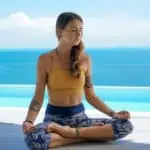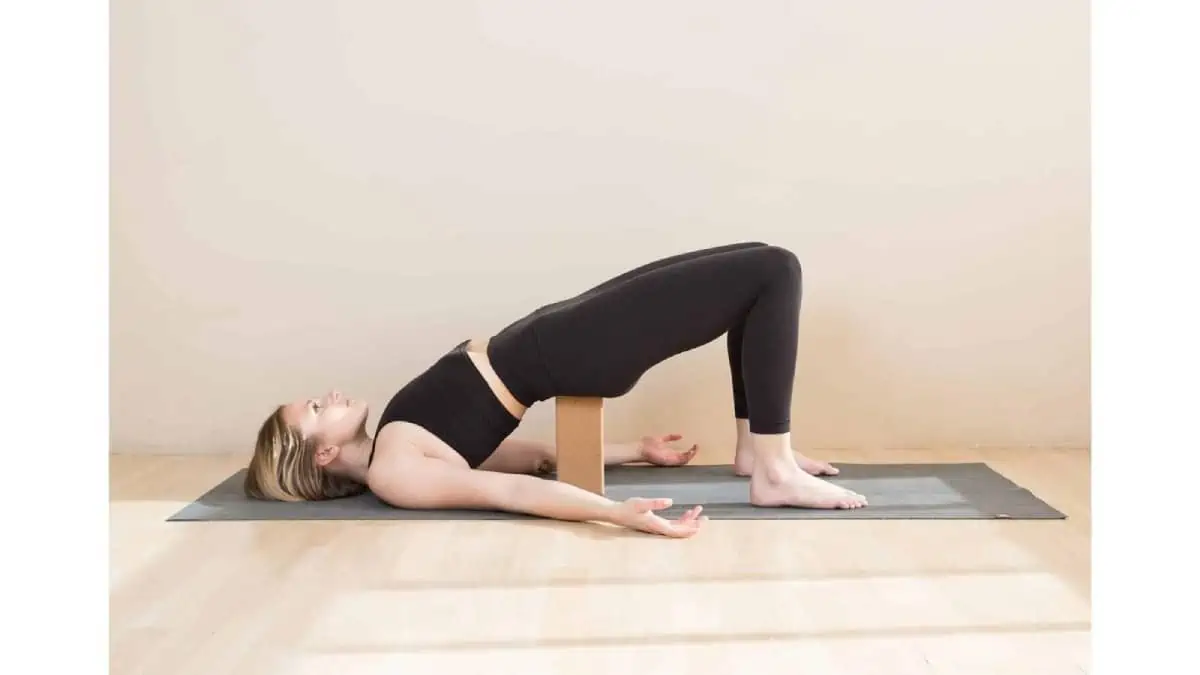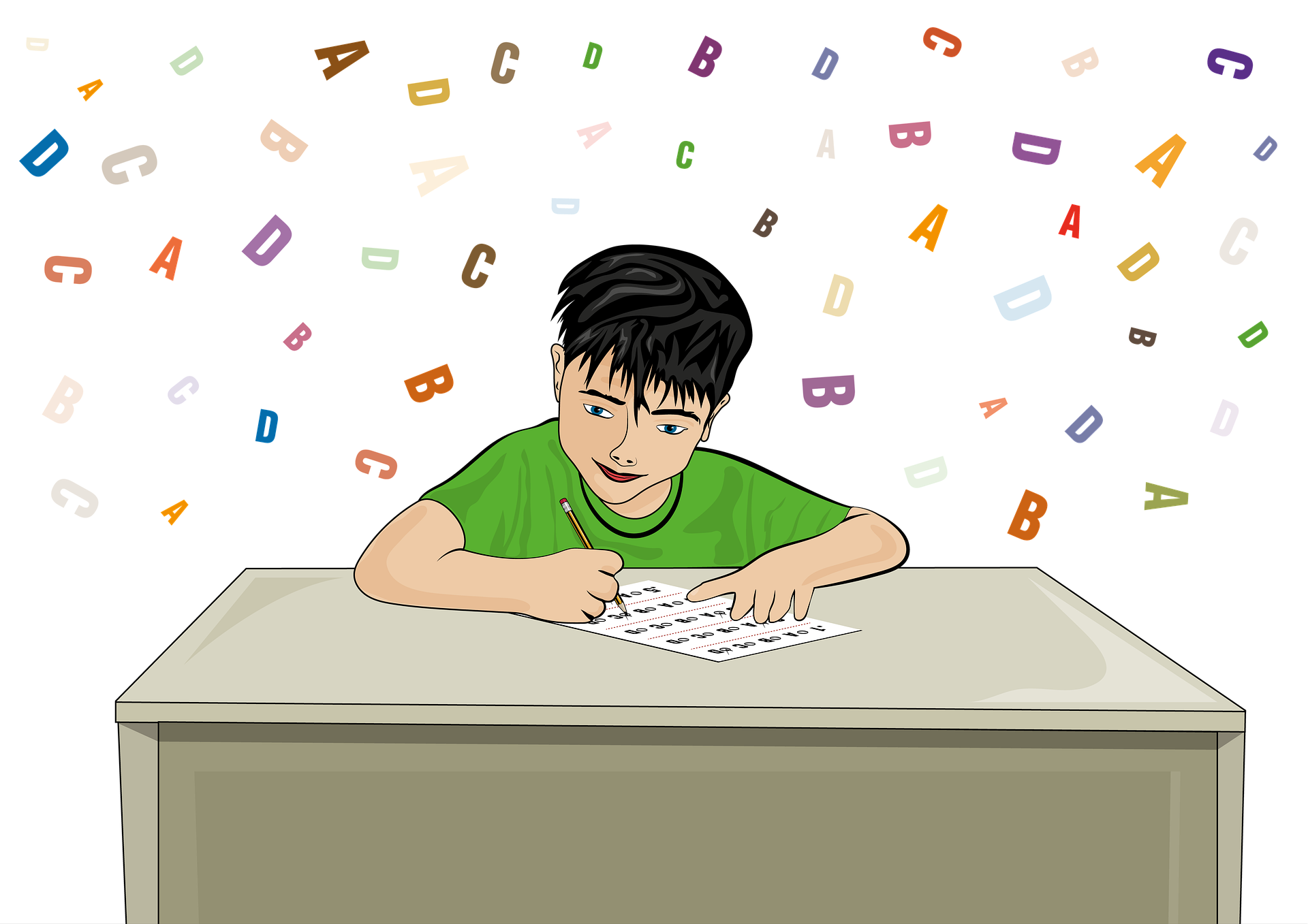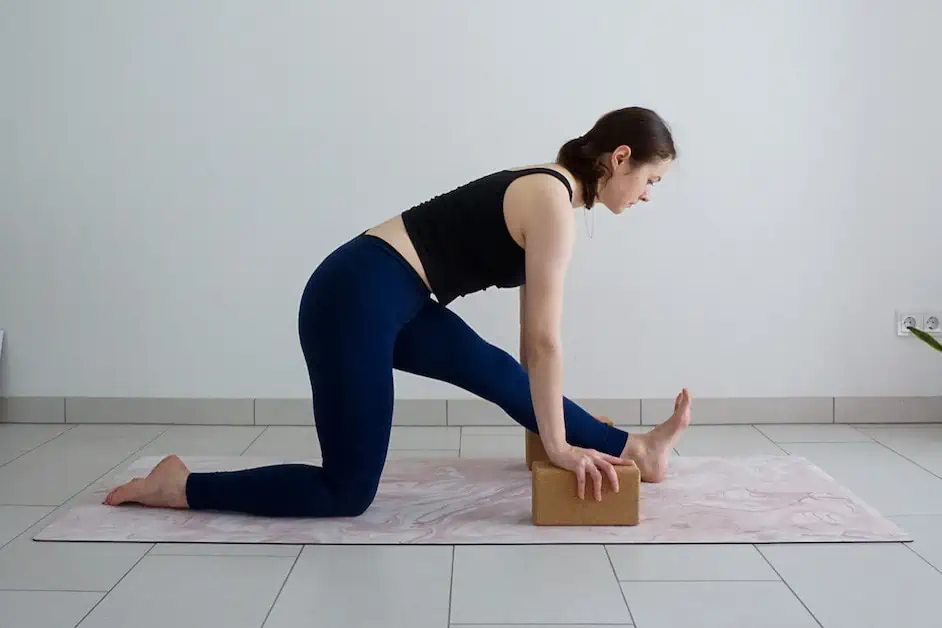Listen to this article:
Key Takeaway
Enhance your yoga practice with blocks to support, deepen, and align poses for all levels.
Any yoga pose can be a ‘block yoga pose.’ Depending on your level of openness and flexibility on any given day, a yoga block can be a nice addition to many of your favorite postures.
Those new to yoga tend to share a common misconception; that an adjustment from a teacher or the need to use a yoga block in a pose is a sign of inexperience. But the truth is, both are useful tools that will help your body open safely and with greater ease.
If you’re ready to glean all the benefits of using yoga blocks in your practice, you’re in the right place.
Below, you’ll learn more about the perks of practicing yoga block stretches.
Prefer video? Here’s a great one we did on the use of yoga blocks:
Contents
Why use yoga blocks in your yoga practice?
Yoga blocks are, in my opinion, a must-have prop for practitioners of all levels. Regardless of how long you’ve been practicing yoga, everyone can benefit from the additional support they offer.
Adding a yoga block to restorative poses can facilitate a deeper opening through the lengthened muscles since they can relax more fully with the additional support. This level of support is imperative in yin yoga classes, where the poses are held for 3-5 minutes.
In a standing sequence, using a yoga block helps to shorten the distance between your hands and the yoga mat, so you can find perfect alignment regardless of your flexibility level.
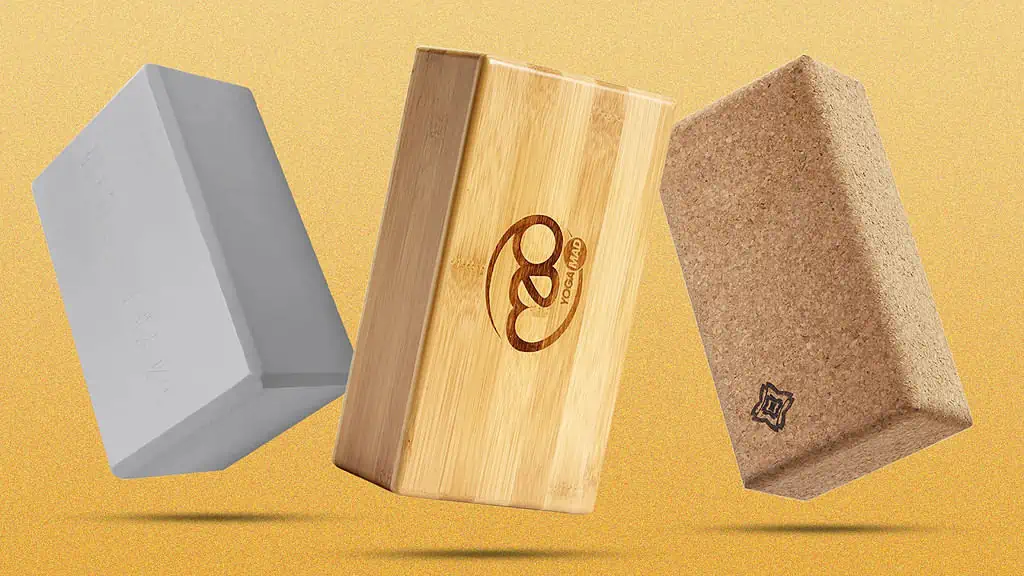
What are the different types of yoga blocks?
When purchasing blocks for your home practice, there are three popular styles for you to choose from:
- Cork blocks:
My personal favorite, cork blocks, have a pleasant weightiness to them that neither wooden nor foam blocks offer. They also feel more grippy than wood and foam, adding an extra sense of stability you will surely appreciate during those tricky standing poses.
- Wooden blocks:
Most wooden blocks come hollowed out in the middle to save them from being too heavy. They are the most rigid of the three options, offering unyielding support when placed under the back or hips.
- Foam blocks:
The most budget-friendly of the three block styles, foam blocks are ideal for beginners. These lightweight blocks are spongier than wood and cork, and because of this, they feel less stable than the previous two options. However, their weight makes them an ideal choice for frequent travelers.
Anyone tight on cash or who enjoys a more minimal lifestyle can likely get away with purchasing a single foam block for their at-home practice. However, I can guarantee anyone with a daily practice won’t regret investing in a pair of cork blocks.
12 Best Block Yoga Poses
Ready to put your yoga blocks to good use? In this next section, I’ll share my favorite block yoga postures and provide tips on how to set up your blocks for each pose.
In many postures, I offer two block variations. The first is ideal for anyone craving more support, either because they are newer to yoga or want a restorative variation. While the latter will help more experienced practitioners segue into more advanced variations.
1: Bridge Pose
Bridge pose is a yoga pose that is great for strengthening the body while simultaneously encouraging a deep opening through the front body, especially through the shoulders.
Beginner yogis, or anyone taking a yin class, may prefer to take a supported bridge pose, which entails placing a block underneath the sacrum to bear some of the body’s weight.
Otherwise, a block can be placed between the inner thighs, encouraging correct alignment through the lower legs and feet as you move into full-wheel pose.
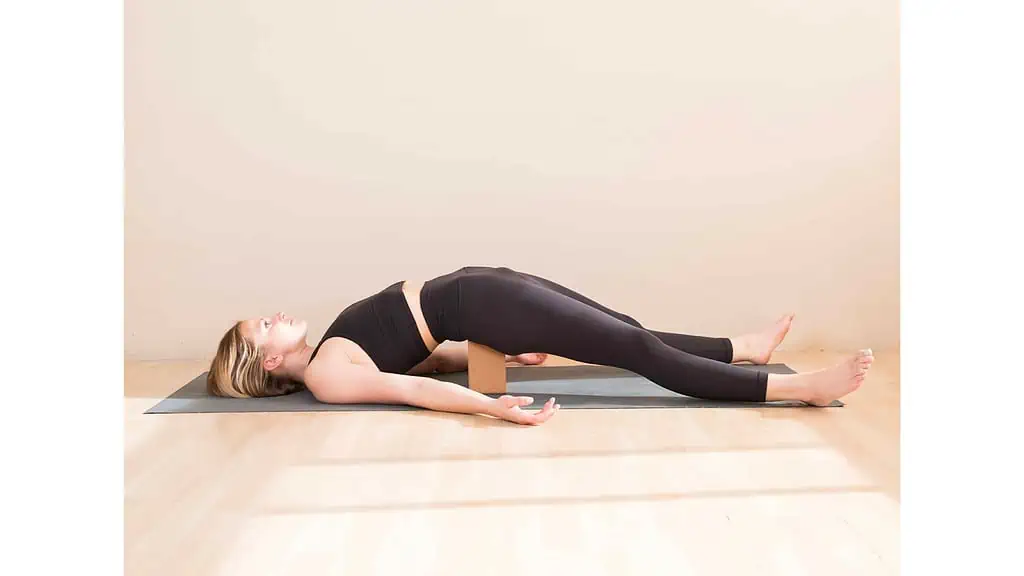
For more support: When in bridge pose, place a block underneath your pelvis or sacrum, ensuring it’s not resting too far onto the spine, since we always wanted to avoid adding unnecessary pressure to the lower back.
Once you’ve found a comfortable block placement and feel stable, you can place both feet flat on the ground directly below your knees, extend your legs toward the bottom of your mat, or straighten both legs while reaching your feet toward the ceiling.
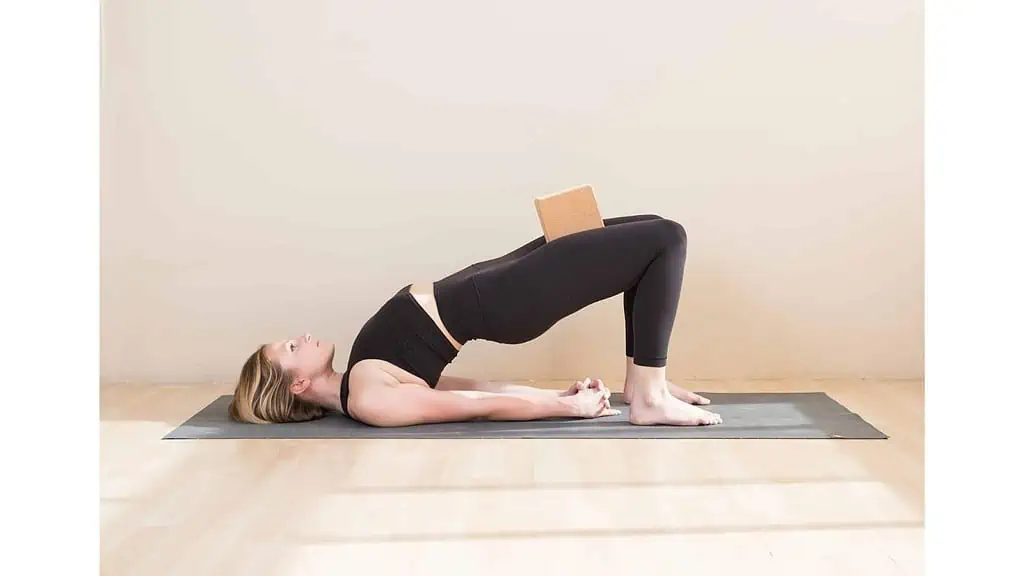
To deepen the posture: Wedge a block between your upper legs, using a squeezing motion through the inner thighs to hold it in place. You can stay with your shoulders connected to the mat or even move into a deeper variation that involves planting the palms and straightening the arms.
Doing either variation with a block between the thighs helps you facilitate proper alignment through the lower legs by preventing a flaring of the knees. Squeezing through the thighs can also promote activation through the ab muscles to support the lower back.
2: Supported fish pose
Supported fish pose is a wonderful addition to all yin yoga classes, as it provides a deep opening through the front body while still being easy to soften into.
Using a block in this pose provides a foundation for the muscles and fascia of the neck, chest, shoulders, and abdominals to relax and lengthen. Once you’ve found a comfortable placement, a supported fish pose is an asana you’ll never want to come out of.
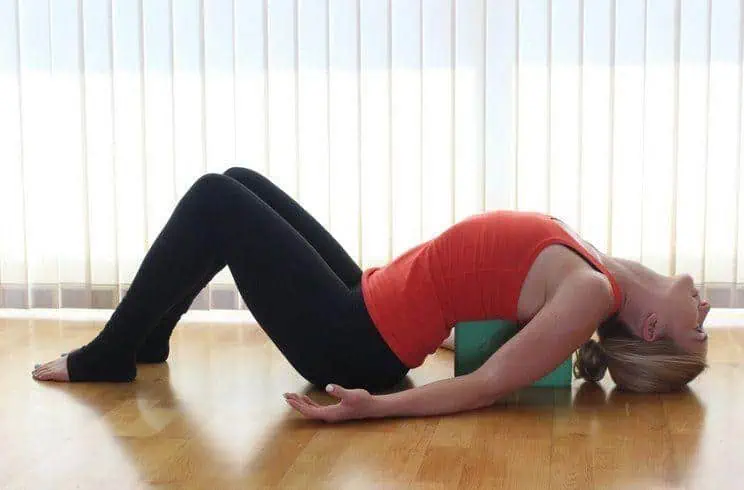
To deepen the posture: Place a block vertically on its highest setting and sit down a foot in front of it. Then, using weight in your palms, slowly begin lowering your back down until the bottom of the block lands just above your sacrum, and the remaining area connects to the spine between the shoulder blades.
After you’ve found a comfortable placement, allow your shoulders and back of the head to soften down towards the mat. If the stretch feels too intense, you can place a second block horizontally under the head to reduce the stretch through the chest.
3: Triangle pose
Triangle pose is one of those asanas in which incorporating blocks can completely alter your experience within the pose. Mostly because the level of opening this pose can provide depends on your ability to firmly plant your bottom hand.
When performed correctly, the triangle pose activates the muscles in the core and legs while encouraging a lengthening through the side body and chest that feels divine.
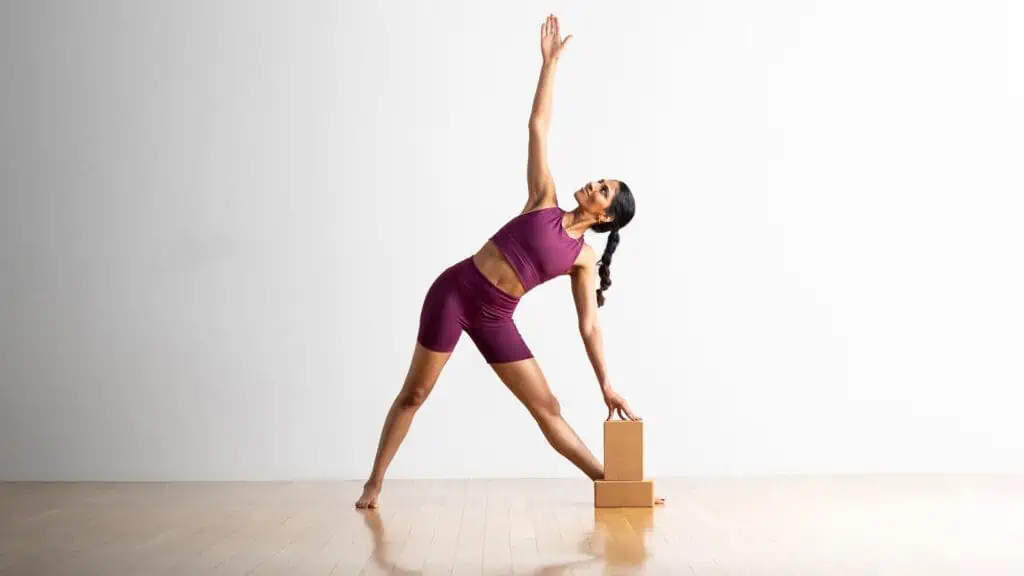
For more support: After setting your legs up for a triangle pose, place a block on one of its three height options, depending on your flexibility level, along the inside edge of your front foot. A firm press of your bottom hand into the block will help you extend your top hand toward the ceiling, enhancing the opening through your chest.
4: Front splits pose
Contrary to popular opinion, the front split is a pose that beginner and advanced yogis alike can practice. It only becomes more accessible when you include blocks for additional support.
Having tight hips can contribute to lower back pain and limit mobility, so finding ways to lengthen them is important, especially if you live a more sedentary lifestyle. Practicing any variation of the splits can help to release tight hip flexors and stretch the muscles in the hamstrings and calves. [1]
For more support: Anyone new to the splits should begin by using two blocks on their highest setting, placed on either side of the extended leg, on which you can press your hands to support the body’s weight and lessen the stretch.
Aim to place the blocks underneath the shoulders. Your hand placement will likely be nearer to the ankles to start, with the blocks moving closer toward the hips as flexibility increases.
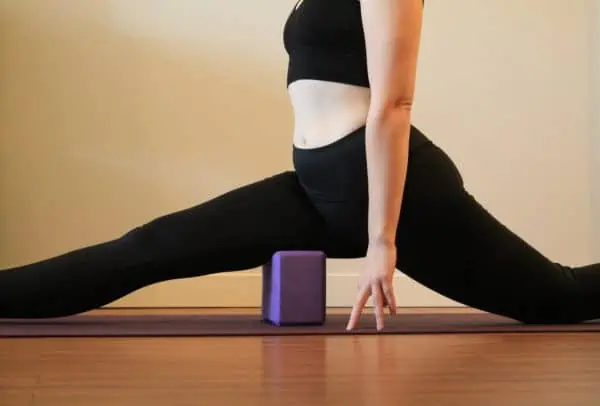
To deepen the posture: When you’re ready to deepen your splits variation, try placing a single block, on one of its two lowest settings, directly underneath the upper thigh of the front leg.
When your thigh connects with the block, your hands will be free to be placed wherever feels best for you. I love placing my hands on my hips and using them to guide my hips toward proper alignment.
5: Downward-facing dog pose
Downward-facing dog is a staple yoga pose that can allow much-needed rest during your practice, but this pose provides this perk only after you find your perfect alignment within it.
Anyone who struggles with wrist pain or inflexibility in the lower body will likely find it difficult to comfortably hold a downward dog for extended periods. If this sounds like you, incorporating blocks is an easy way to make this feel more like a restorative pose.
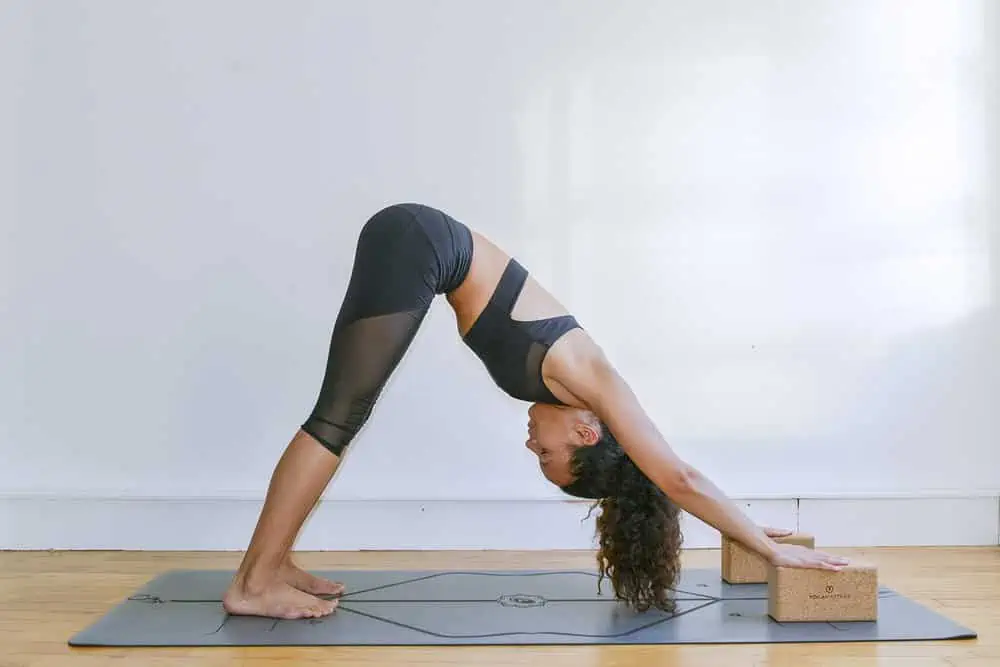
For more support: Place two blocks on their lowest setting at the top of your mat, just wider than shoulder-width apart, on which you can place your palms. Using blocks to raise your wrists helps to shift more of the body’s weight back, where the legs instead of the wrists can support it.
Raising the wrists also decreases the angle of your wrists, making it easy for anyone with inflexible wrists to alleviate the pressure on this sensitive joint.
6: Side-angle pose
The side-angle pose is one of my favorite standing poses since it seamlessly combines strengthening of the legs, activation of the core muscles, and delightful stretching through the side body.
Though technically a beginner-friendly pose, finding the right balance can be difficult initially. Incorporating a block into this pose can create more space between the upper thigh and chest, allowing you to easily find your perfect alignment.
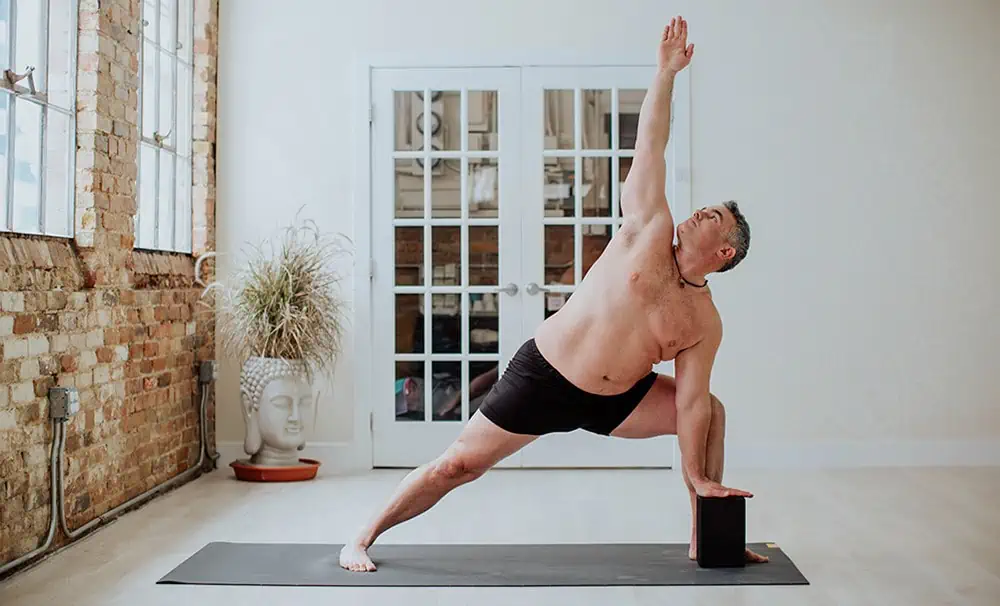
For more support: After setting your legs up for a side-angle pose, place a block on the inside edge of your front foot that you can use to support the palm of your bottom hand. Depending on your flexibility level, you can use the yoga block on either of its three height options.
A firm press of your palm down into the block will allow you to extend your top hand further, enhancing the opening through the front of your body.
7: Puppy pose
Puppy pose is extremely useful for anyone who suffers from tight shoulders. It can help to stretch the pectoral muscles, countering the hunching of the shoulders that can result from long hours spent sitting at a desk each day.
Placing yoga blocks under the elbows can create more space between the face and mat, creating more space for you to stretch through the triceps, shoulders, and pectoral muscles.
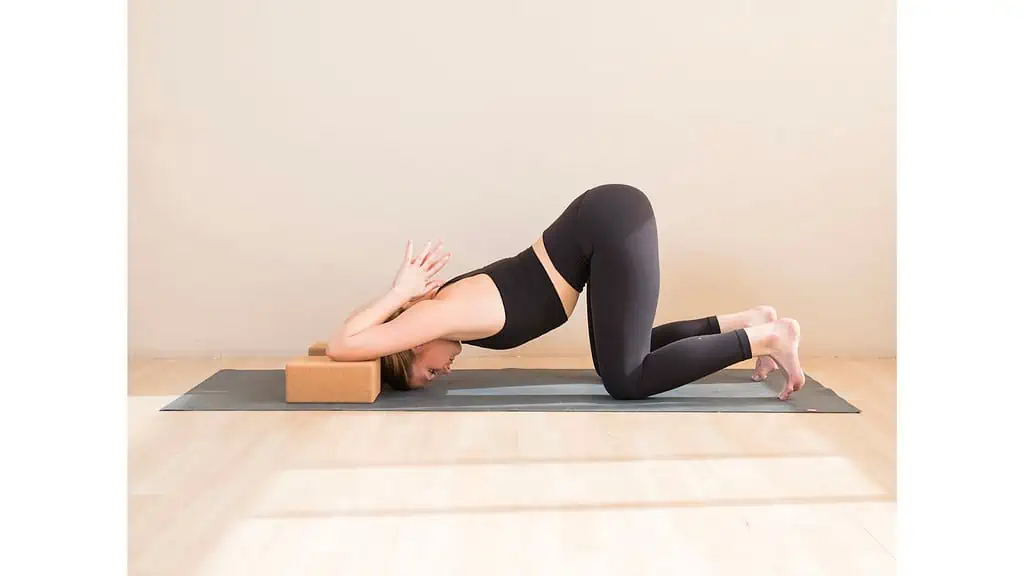
To deepen the posture: Place two blocks at the top of your mat, shoulder-distance apart or a little wider than shoulder-distance apart, for you to rest your elbows on.
After finding a comfortable resting place for your elbows, you can remain there or begin drawing your chest and head down toward the mat for a deeper stretch through the shoulder blades.
8: Seated forward fold pose
There are many variations of the seated forward fold, and all of them are incredibly useful for opening up the entirety of the backside of the body, from your calves through your shoulders.
In this posture, you can use a block under the forehead to make the pose feel more restorative, or if you’re ready for a deeper stretch, extend the length of your legs by placing a block below your feet. Don’t forget to flex your feet to enhance the stretch through your lower legs!
For more support: Start by finding a comfortable seat and then placing a yoga block on its highest setting between your legs. Keeping the back straight, begin hinging at the hips until your forehead meets the block.
Less-flexible yogis will likely place the block more toward their inner thighs and might need to keep their knees bent to reach the block with their forehead. Regardless of your yoga block placement, using a prop will encourage a deeper relaxation of the neck and shoulders.
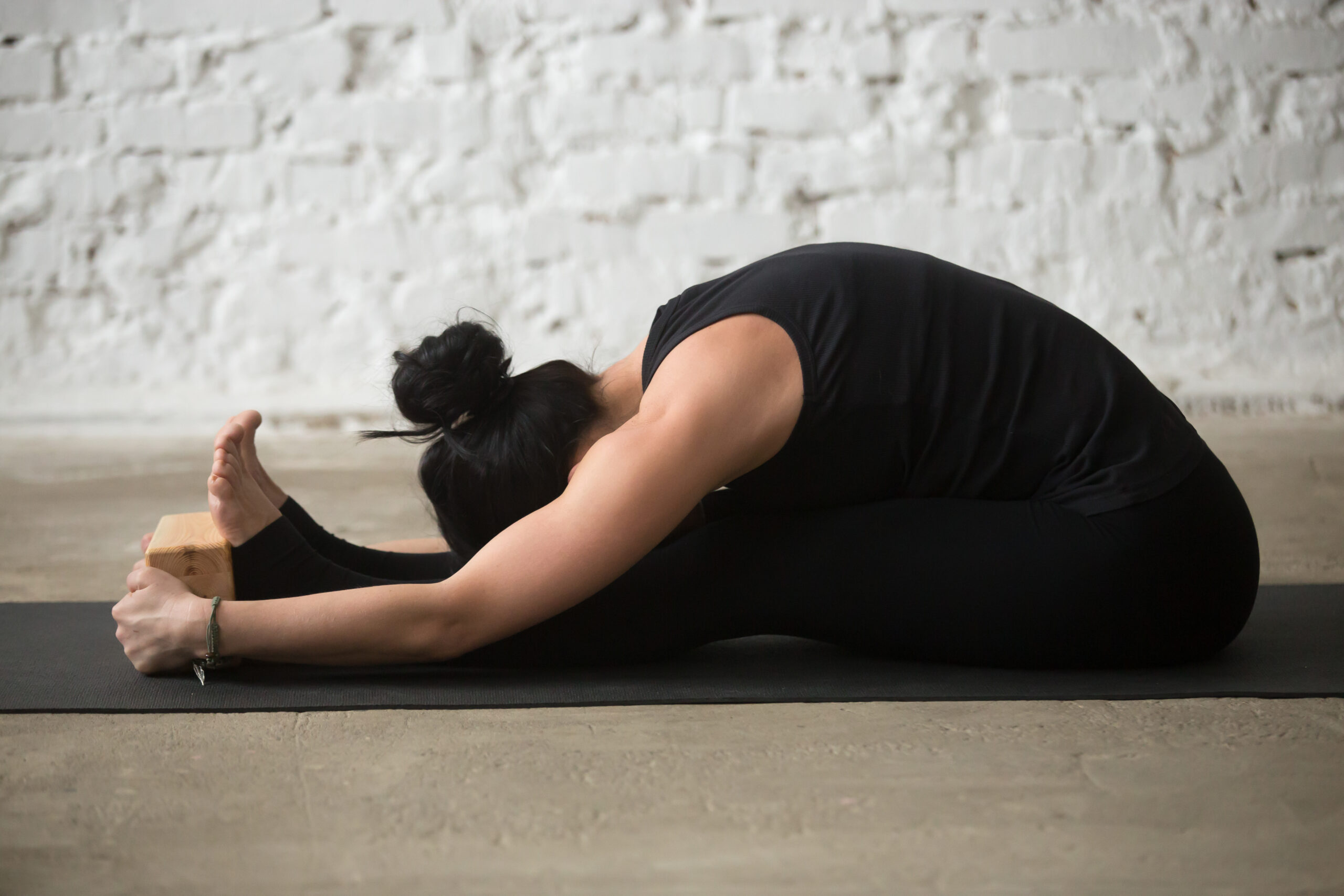
For a deeper stretch: This variation is for anyone requiring a deeper stretch in their forward fold. Simply place a single yoga block at its medium height at the bottom of your feet and use your hands on either side to pull your torso forward. Keep your legs straight and your feet flexed to maximize the stretch through your calves and hamstrings.
9: Half-moon pose
If you’re looking to challenge your balance and build strength in your legs, a half-moon pose is a great option. Using yoga blocks in this pose is ideal for anyone who struggles with flexibility and can create more space along the sides of the body, making it easier to maintain proper alignment.
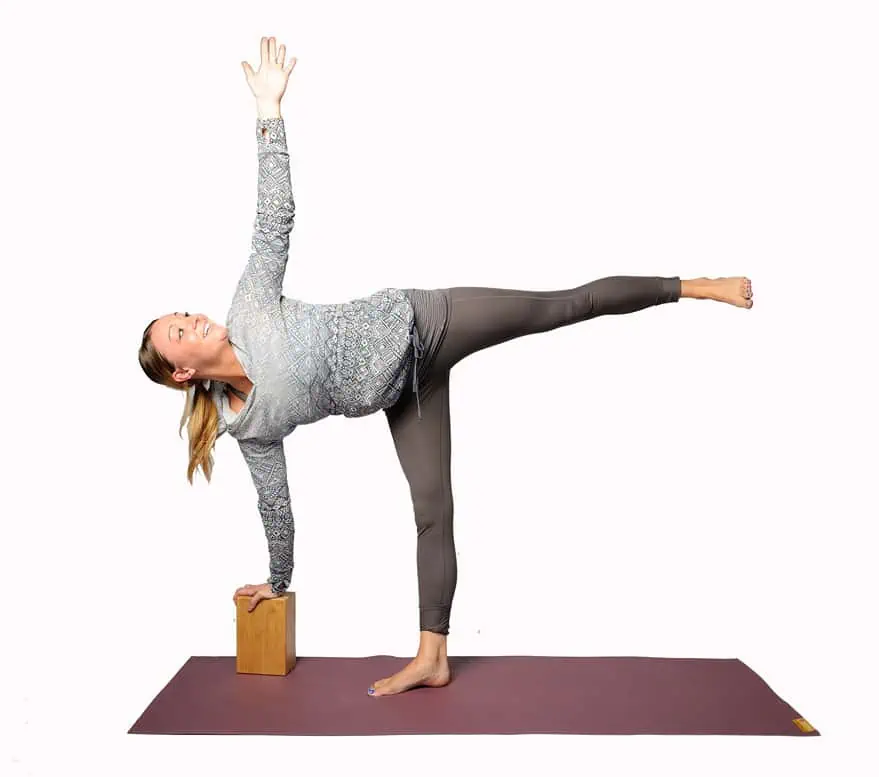
For more support: Start by placing a block around 12” in front of your standing leg, a little to the outside edge of your front foot. Slowly lower your upper body down until the palm of your bottom hand connects with the block.
Use the pressure of your bottom hand against the block to reach your top hand up and your extended leg toward the back of your mat.
10: Pigeon pose
Pigeon pose is another one of my favorite asanas. It provides a delightful opening through the hip flexors, and the full posture, which includes binding both hands to the back foot – is stunning.
Since proper alignment in this pose form involves squaring the hips, a yoga block is an essential prop for beginners who struggle with inflexible hip flexors.
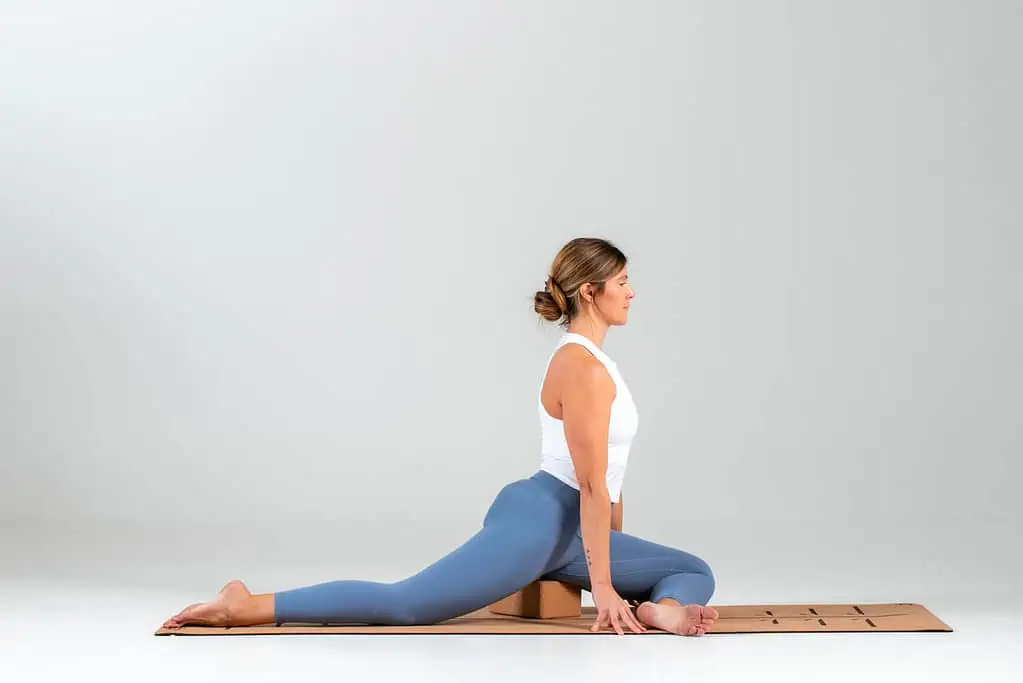
For more support: Start by placing a block in the middle of your mat and coming into a downward-facing dog. Then step your right or left foot forward, bringing your shin down to the mat, and place the glute of your front leg down onto the block.
From there, you can keep both hands down on the mat or place your hands on your hips, helping to draw the hip of your back leg down to further square the hips.
11: Crow pose
Crow pose is one of the more challenging poses in yoga. Still, few feelings are better than finding the perfect alignment in an arm balance and finally experiencing yourself lift off the ground!
It takes a combination of upper body strength and perfect alignment to maintain proper form in an arm balance such as the crow pose. For beginner yogis, a yoga block can greatly support you while you find your wings.
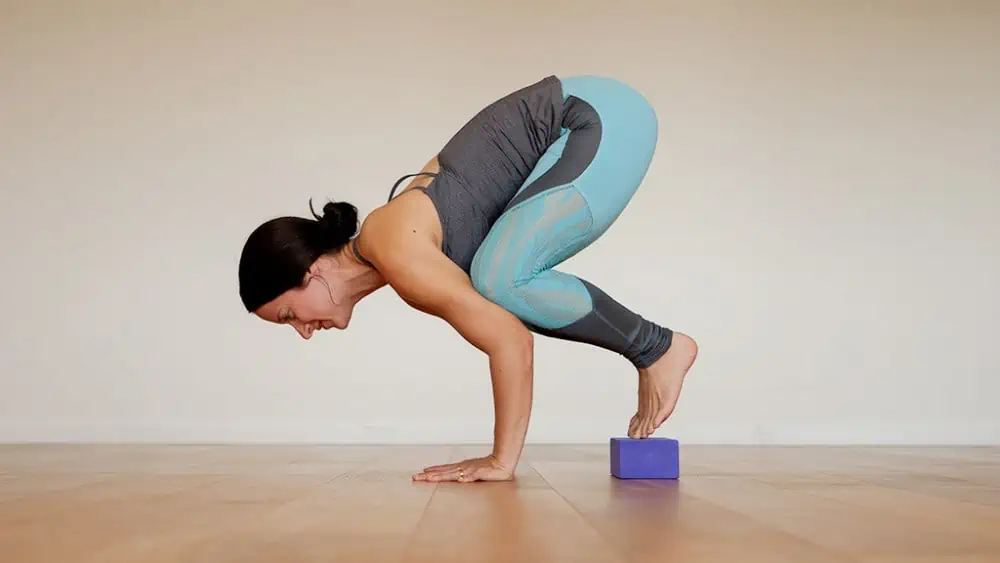
For more support: Start by crouching down with your feet on either side of the yoga block. Place your palms on the mat around a foot in front of your feet, and bring your toes onto the block. Then, bending your elbows, place your knees on the backs of your triceps.
Keep your head up and lean your weight forward slightly until you feel your arms engage. You can either stay like this or practice lifting one foot off the block, followed by the other.
12: Camel pose
Camel pose is the ultimate front-body opener and involves either strengthening or lengthening just about every muscle in the body. Because of that, it can be a challenging pose for beginners and something that many practitioners will skip when given a choice.
Anyone wanting to include camel pose in their practice to enjoy some of its many benefits can do so more easily by incorporating blocks to support proper form.
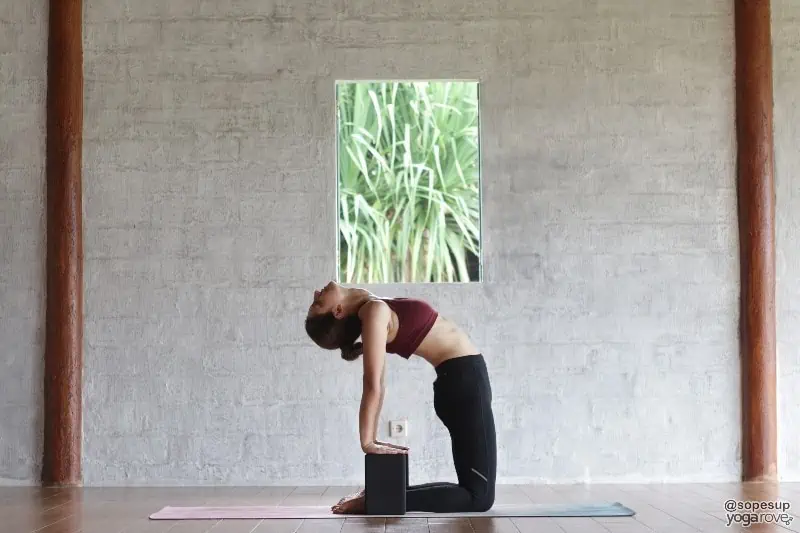
For more support: Start by kneeling on your mat and placing two yoga blocks on the outside edges of your ankles. Press both palms firmly down on the blocks, using the pressure to lift your hips forward and up.
Once you feel your hips stack over your ankles, engage the thigh and core muscles to support you as you draw your shoulder blades together to encourage a deep opening through the chest.
Exploring Flexibility Through Yoga Block Stretches
Utilizing Blocks for Flexibility
The use of blocks can truly transform your flexibility journey. Acting as an extension of your arms, they bring the ground closer, which is particularly beneficial in poses where reaching the floor with your hands is a challenge. By providing these support blocks, we help maintain alignment for safe stretching practices and injury prevention.
Furthermore, blocks facilitate stretches. For example, when placed under your feet during a fold, they intensify the stretch on your hamstrings. This gentle elevation enables a secure stretch—a bit like having a knowledgeable assistant guide you on how to push without risking harm.
In addition, using blocks aids in holding poses for durations—an element, for enhancing flexibility. The ability to sustain a stretch comfortably allows muscles to gradually relax and elongate over time. With block support, you’re more likely to sustain stretches without overexerting yourself.
Here’s where the magic of flexibility shines.
Integrating blocks into your routine to enhance flexibility isn’t just effective; it’s a way to add variety and challenge to your practice. As your flexibility increases, you have the option to adjust the block height or even do away with them entirely. This gradual progression keeps your body engaged and evolving.
So the next time you unroll your yoga mat, grab a set of blocks. Explore how they can enhance your stretches. Observe their impact on your practice, elevating your flexibility to new levels. Remember, yoga is a journey, and these blocks are here to support you every step of the way.
Exploring Mindfulness and Concentration through Yoga Block Exercises
Yoga blocks aren’t merely tools for support; they also aid in emotional alignment. For example, positioning a block under my hand in a Triangle Pose not only provides stability but also helps me center my focus. It draws me deeper into the moment, turning each stretch into a meditative journey.
Furthermore, these blocks act as cues to maintain awareness of our body’s alignment and weight distribution. This mindfulness can foster a connection, with our body’s energies and sensations elevating the overall yoga experience beyond just the poses themselves.
Adding this viewpoint to your blog might provide readers with a perspective on utilizing yoga blocks, highlighting the advantages of a mindful practice that extends beyond just the physical aspects to encompass mental and emotional well-being.
Pop quiz! 🧘🤔
Using yoga blocks is only for beginners.
Yoga blocks can help deepen your stretch in poses like Triangle Pose.
You should avoid using yoga blocks in standing poses.
FAQs
What poses do yoga blocks use?
You can use yoga blocks in any pose that you feel requires more support or length than your body can offer. Some popular block yoga poses include triangle pose (trikonasana), half moon pose (ardha chandrasana), and pigeon pose (kapotasana).
Are yoga blocks for beginners?
Although blocks are especially useful for helping beginner yogis find proper alignment, the truth is that everyone can benefit from using blocks. Whether to offer additional support on less flexible days or assist in additional lengthening when the body feels more open, yoga blocks are for everyone.
Do you need one or two yoga blocks?
Whether or not you need one or two yoga blocks will depend on the yoga pose you want to use the blocks for. You can use one block for one-handed poses like triangle poses, but two blocks will be required to support both hands simultaneously in poses such as the downward-facing dog.
That being said, a single block can do the trick in most poses if you don’t want to invest in two.

